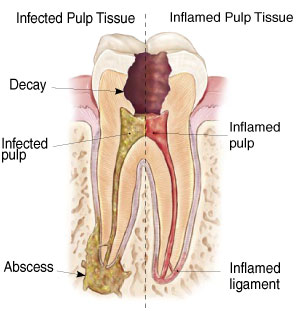 The diseases in pulp can occur due to any of the bacterial, physical, chemical or radiation reasons. The bacterial irritants can first attack the upper layers of teeth, like the enamel and dentin, which later progresses to involve the pulp.
The diseases in pulp can occur due to any of the bacterial, physical, chemical or radiation reasons. The bacterial irritants can first attack the upper layers of teeth, like the enamel and dentin, which later progresses to involve the pulp.
Grossman classified the diseases of pulp into various categories, depending on the type of pathology, namely –
I. Pulpitis
Inflammation of the pulp. This may occur due to caries, or trauma or due to multiple restorations, where recurrent caries can occur. The principal symptom of Pulpitis is pain. The pulpitis begins as a reversible condition initially, which later progresses to become irreversible if not treated by a simple filling. The pulp becomes necrotic, and leads to infection around the apex of the root in the later stages.
Pulpitis can further be classified into the following types –
a. Reversible Pulpitis
– Symptomatic (Acute)
– Asymptomatic (Chronic)
b. Irreversible Pulpitis
i. Acute
– Abnormally responsive to cold
– Abnormally responsive to heat
ii. Chronic
– Asymptomatic with pulp exposure
– Hyperplastic pulpitis
– Internal resorption
II. Pulp Degeration
This condition is usually seen in older people, where persistent mild irritation to the teeth leads to degeneration of the pulp. It may be induced by the attrition of the teeth, bacteria, erosion etc. and if that progresses, it may get discolored and there would be no response from the pulp to any type of stimulation.
It may be –
a. Calcific degeneration (confirmed by radiographic diagnosis)
b. Other (confirmed by histopathologic diagnosis)
III. Pulp Necrosis
Necrosis is the death of the pulp, and it may be partial or total, depending on the amount of pulp involved and can occur due to either inflammation or due to any traumatic injury. The necrosis of the pulp can be either Coagulation necrosis or Liquefaction necrosis.
——
There are several other classifications suggested for the Pulpal pathologies, but the most standard one is the Grossman classification, which groups them based on the type of pathology.
Thanks for sharing such a useful information. It is a good information about Types of Pulpal Diseases by Grossman. Pulp is the essence of the tooth. Pulpal diseases is effected to the tooth. So contactto your doctor.
english student